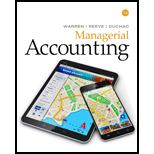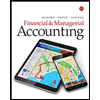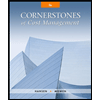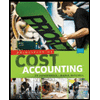
Part–A
(1)
Direct material variances:
The difference between the actual material cost per unit and the standard material cost per unit for the direct material purchased is known as direct material cost variance. The direct material variance can be classified as follows:
- Direct materials price variance.
- Direct materials quantity variance.
Direct labor variances:
The difference between the actual labor cost in the production and the
- Labor rate variance.
- Labor time variance.
Variable factory overhead controllable variances:
The difference between the actual variable overhead costs and the standard overhead for actual production is known as the variable factory overhead controllable variances. The variable factory overhead controllable variance is computed as follows:
Fixed factory overhead volume variances:
Factory overhead volume variances refers to the difference between the budgeted fixed
The fixed and variable portion of the utility cost using the high-low method.
Part–A
(1)
Explanation of Solution
The fixed, and variable portion of the utility cost using the high-low method is $500,and $240 in the high cost method, and $500,and $100 in the low cost method respectively.
Working Notes:
Calculate the variable cost per unit.
Calculate the fixed and variable portion of the utility cost using high method:
Calculate the fixed and variable portion of the utility cost using low method:
Hence, using the high method, the fixed and variable portion of the utility cost is $500, and $240. On the other hand, using the low method, the fixed and variable portion of the utility cost is $500, and $100 respectively.
Part–B
5.
To prepare: The August production budget.
Part–B
5.
Answer to Problem 5CP
|
Incorporation GS For the month ended August 31 | |||
| Sales (9) | $ 150,000 | ||
| Finished goods inventory, August 1 | $ 12,000 | ||
| Direct materials: | |||
| Direct materials inventory, August 1 (10) | $ 392 | ||
| Direct materials purchases (Table 4) | 23,231 | ||
| Cost of direct materials available for use | $ 23,623 | ||
| Less: Direct materials inventory, August 31 (11) | 248 | ||
| Cost of direct materials used in production | $ 23,375 | ||
| Direct labor (Table 5) | 9,900 | ||
| Factory overhead (Table 6) | 19,735 | ||
| Cost of goods manufactured | 53,010 | ||
| Cost of finished goods available for sale | $ 65,010 | ||
| Less: Finished goods inventory, August 31 | 7,000 | ||
| Cost of goods sold | 58,010 | ||
| Gross profit | $ 91,990 | ||
| Less: Selling expenses | 30,000 | ||
| Income from operations | $ 61,990 | ||
Table (7)
Explanation of Solution
Prepare the production budget for the month of August.
| Incorporation GS | |
| Production Budget | |
| For the month ended August 31 | |
| Particulars | Cases |
| Expected cases to be sold | 1,500 |
| Plus desired ending inventory | 175 |
| Total units required | 1,675 |
| Less: Estimated beginning inventory | 300 |
| Total units to be produced | 1,375 |
Table (3)
Part–C
10.
To determine and interpret: The direct materials price and quantity variances for the three materials.
Part–C
10.
Explanation of Solution
Determine the direct materials price variances for the three materials.
| Cream Base | Natural oils | Bottles | |
| Actual price | $ 0.016 | $0.32 | $0.42 |
| Less: Standard price | 0.020 | 0.30 | 0.50 |
| Difference | $(0.004) | 0.02 | $(0.08) |
| Multiply: Actual quantity | 153,000 (13) | 46,500 (14) | 18,750 (15) |
| Direct materials price variance | $(612) Favorable |
$930 (Unfavorable) | $(1,500) Favorable |
Table (8)
Working Note:
Interpretation:
It can be understood from the above data that there is variances in the direct materials prices due to the fluctuations in the market prices. The actual price for natural oils got increased when compared to its standard price, whereas, the actual prices for the cream base, and bottles got decreased when compared to their respective standard prices.
Want to see more full solutions like this?
Chapter 8 Solutions
Managerial Accounting, Loose-leaf Version
- Carlyon Company listed the following items in its December 31, Year 1, financial statements: Investment in Man Company bonds $21,000 Dividends payable: preferred 4,000 Dividends payable: common 50,000 Preferred stock, 8%, $100 par 100,000 Common stock, $10 par 500,000 Additional paid-in capital on preferred stock 20,000 Additional paid-in capital on common stock 262,500 Retained earnings 270,000 During Year 2, the following transactions occurred: Feb. 2 Paid the semiannual dividends declared on December 15, Year 1. Mar. 5 Declared a property dividend, payable to common shareholders on April 5 in Man Company bonds being held to maturity. The bonds (which have a book value of $21,000) have a current market value of $30,000. Apr. 5 Paid the property dividend. Jul. 6 Declared a $4 per share semiannual cash dividend on preferred stock and a $1.10 per share semiannual dividend on common stock, to be paid on August 17. Aug. 17 Paid the cash dividends.…arrow_forwardRequired information [The following information applies to the questions displayed below.] Jarvie loves to bike. In fact, he has always turned down better-paying jobs to work in bicycle shops where he gets an employee discount. At Jarvie's current shop, Bad Dog Cycles, each employee is allowed to purchase four bicycles a year at a discount. Bad Dog has an average gross profit percentage on bicycles of 25 percent. During the current year, Jarvie bought the following bikes: Description Retail Price Specialized road bike $ 4,000 Cost $ 3,600 Employee Price $ 2,800 Rocky Mountain mountain bike 5,000 4,100 4,000 Trek road bike 3,900 3,300 2,730 Yeti mountain bike 4,600 3,400 3,680 b. What amount of deductions is Bad Dog allowed to claim from these transactions? Amount of deductionsarrow_forwardJarvie loves to bike. In fact, he has always turned down better-paying jobs to work in bicycle shops where he gets an employee discount. At Jarvie's current shop, Bad Dog Cycles, each employee is allowed to purchase four bicycles a year at a discount. Bad Dog has an average gross profit percentage on bicycles of 25 percent. During the current year, Jarvie bought the following bikes: Description Retail Price Specialized road bike $ 4,000 Cost $ 3,600 Employee Price $ 2,800 Rocky Mountain mountain bike 5,000 4,100 4,000 Trek road bike 3,900 3,300 2,730 Yeti mountain bike 4,600 3,400 3,680 a. What amount is Jarvie required to include in taxable income from these purchases? Amount to be includedarrow_forward
- Yost received 300 NQOs (each option gives Yost the right to purchase 10 shares of Cutter Corporation stock for $19 per share). At the time he started working for Cutter Corporation three years ago, Cutter's stock price was $19 per share. Yost exercised all of his options when the share price was $38 per share. Two years after acquiring the shares, he sold them at $59 per share. Note: Input all amounts as positive values. Leave no answer blank. Enter zero if applicable. d. Assume that Yost's options were exercisable at $24 and expired after five years. If the stock only reached $22 during its high point during the five-year period, what are Yost's tax consequences on the grant date, the exercise date, and the date the shares are sold, assuming his ordinary marginal rate is 35 percent and his long-term capital gains rate is 15 percent? Grant date Exercise date Taxes Due Sale datearrow_forwardMark received 10 ISOs (each option gives him the right to purchase 14 shares of Hendricks Corporation stock for $6 per share) at the time he started working for Hendricks Corporation five years ago, when Hendricks's stock price was $5 per share. Now that Hendricks's share price is $35 per share, Mark intends to exercise all of his options and hold all of his shares for more than one year. Assume that more than a year after exercise, Mark sells the stock for $35 a share. Note: Enter all amounts as positive values. Leave no answers blank. Enter zero if applicable. b. What are Hendricks's tax consequences on the grant date, the exercise date, and the date Mark sells the shares? Grant date Exercise date Sale date Tax Benefitarrow_forwardYost received 300 NQOs (each option gives Yost the right to purchase 10 shares of Cutter Corporation stock for $19 per share). At the time he started working for Cutter Corporation three years ago, Cutter's stock price was $19 per share. Yost exercised all of his options when the share price was $38 per share. Two years after acquiring the shares, he sold them at $59 per share. Note: Input all amounts as positive values. Leave no answer blank. Enter zero if applicable. c. Assume that Yost is "cash poor" and needs to engage in a same-day sale in order to buy his shares. Due to his belief that the stock price is going to increase significantly, he wants to maintain as many shares as possible. How many shares must he sell in order to cover his purchase price and taxes payable on the exercise? Number of shares to be soldarrow_forward
- Mark received 10 ISOs (each option gives him the right to purchase 14 shares of Hendricks Corporation stock for $6 per share) at the time he started working for Hendricks Corporation five years ago, when Hendricks's stock price was $5 per share. Now that Hendricks's share price is $35 per share, Mark intends to exercise all of his options and hold all of his shares for more than one year. Assume that more than a year after exercise, Mark sells the stock for $35 a share. Note: Enter all amounts as positive values. Leave no answers blank. Enter zero if applicable. a. What are Mark's taxes due on the grant date, the exercise date, and the date he sells the shares, assuming his ordinary marginal rate is 32 percent and his long-term capital gains rate is 15 percent? Grant date Exercise date Sale date Taxes Duearrow_forwardOn January 1, year 1, Dave received 2,500 shares of restricted stock from his employer, RRK Corporation. On that date, the stock price was $13 per share. On receiving the restricted stock, Dave made the 83(b) election. Dave's restricted shares will vest at the end of year 2. He intends to hold the shares until the end of year 4, when he intends to sell them to help fund the purchase of a new home. Dave predicts the share price of RRK will be $33 per share when his shares vest and $54 per share when he sells them. Assume that Dave's price predictions are correct, and answer the following questions: Note: Leave no answers blank. Enter zero if applicable. Round your final answer to the nearest whole dollar value. Enter all amounts as positive values. b. What are the tax consequences of these transactions to RRK? Grant date Tax consequences Vesting date $ 0 Sale date $ 0arrow_forwardMeg works for Freedom Airlines in the accounts payable department. Meg and all other employees receive free flight benefits (for the employee, family, and 10 free buddy passes for friends per year) as part of its employee benefits package. If Meg uses 15 flights with a value of $6,975 this year, how much must she include in her compensation this year? Amount includedarrow_forward
- Seiko's current salary is $101,000. Her marginal tax rate is 32 percent, and she fancies European sports cars. She purchases a new auto each year. Seiko is currently a manager for Idaho Office Supply. Her friend, knowing of her interest in sports cars, tells her about a manager position at the local BMW and Porsche dealer. The new position pays $84,600 per year, but it allows employees to purchase one new car per year at a discount of $19,400. This discount qualifies as a nontaxable fringe benefit. In an effort to keep Seiko as an employee, Idaho Office Supply offers her a $10,500 raise. Answer the following questions about this analysis. a. What is the annual after-tax cost to Idaho Office Supply if it provides Seiko with the $10,500 increase in salary? Note: Ignore payroll taxes. After-tax costarrow_forwardRequired information [The following information applies to the questions displayed below.] Nicole's employer, Poe Corporation, provides her with an automobile allowance of $42,000 every other year. Her marginal tax rate is 32 percent. Answer the following questions relating to this fringe benefit. b. What is Poe's after-tax cost of providing the auto allowance? > Answer is complete but not entirely correct. After-tax cost $ 28,560arrow_forward100%, equity, ending inventory. On January 1, 2015, 100% of the outstanding stock of Solo Company was purchased by Plato Corporation for $3,300,000. At that time, the book value of Solo’s net assets equaled $3,000,000. The excess was attributable to equipment with a 10-year life. The following trial balances of Plato Corporation and Solo Company were prepared on December 31, 2015: Plato Corporation Solo Company Cash 735000 37000 Accounts Receivable 400000 365000 Inventory 600000 275000 Property,Plato and Equipment 4000000 2300000 Investment in Solo company 3510000 Accounts Payable (35000) (100000) Common stock ($10 par) (1000000) (400000) Paid-in capital in excess of par (1500000) (200000) Retained earnings, Jan 1, 2015 (5,500,000) (2,400,000) Sales (12,000,000) (1,000,000) Cost of goods sold 7,000,000 750,000 Other expenses 4,000,000 40,000 Subsidiary income…arrow_forward
 Managerial AccountingAccountingISBN:9781337912020Author:Carl Warren, Ph.d. Cma William B. TaylerPublisher:South-Western College Pub
Managerial AccountingAccountingISBN:9781337912020Author:Carl Warren, Ph.d. Cma William B. TaylerPublisher:South-Western College Pub Financial And Managerial AccountingAccountingISBN:9781337902663Author:WARREN, Carl S.Publisher:Cengage Learning,
Financial And Managerial AccountingAccountingISBN:9781337902663Author:WARREN, Carl S.Publisher:Cengage Learning, Financial & Managerial AccountingAccountingISBN:9781337119207Author:Carl Warren, James M. Reeve, Jonathan DuchacPublisher:Cengage Learning
Financial & Managerial AccountingAccountingISBN:9781337119207Author:Carl Warren, James M. Reeve, Jonathan DuchacPublisher:Cengage Learning- Principles of Accounting Volume 2AccountingISBN:9781947172609Author:OpenStaxPublisher:OpenStax College
 Cornerstones of Cost Management (Cornerstones Ser...AccountingISBN:9781305970663Author:Don R. Hansen, Maryanne M. MowenPublisher:Cengage Learning
Cornerstones of Cost Management (Cornerstones Ser...AccountingISBN:9781305970663Author:Don R. Hansen, Maryanne M. MowenPublisher:Cengage Learning Principles of Cost AccountingAccountingISBN:9781305087408Author:Edward J. Vanderbeck, Maria R. MitchellPublisher:Cengage Learning
Principles of Cost AccountingAccountingISBN:9781305087408Author:Edward J. Vanderbeck, Maria R. MitchellPublisher:Cengage Learning





